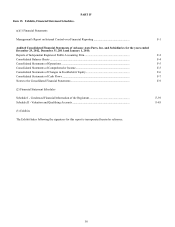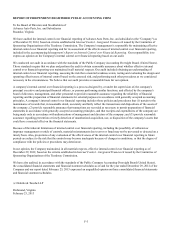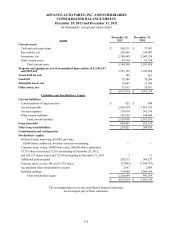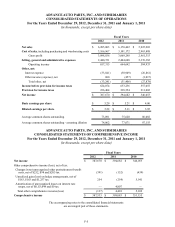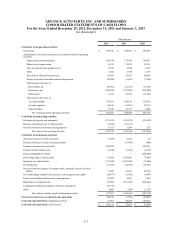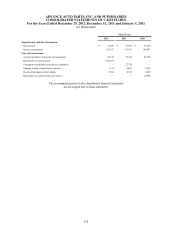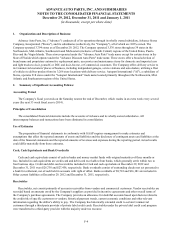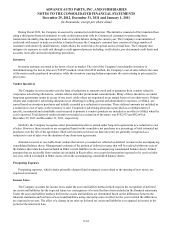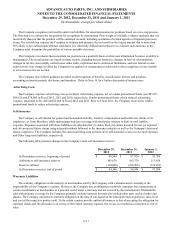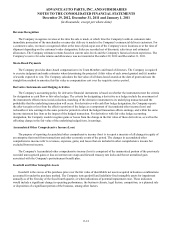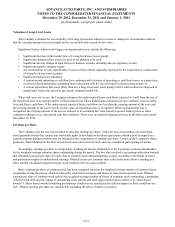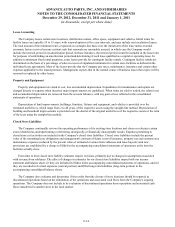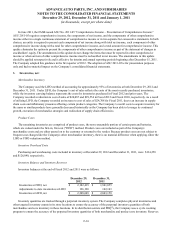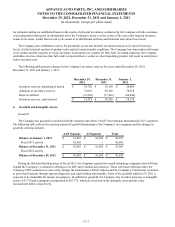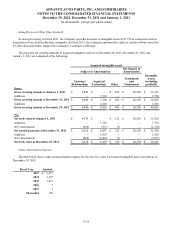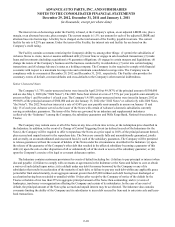Advance Auto Parts 2012 Annual Report Download - page 55
Download and view the complete annual report
Please find page 55 of the 2012 Advance Auto Parts annual report below. You can navigate through the pages in the report by either clicking on the pages listed below, or by using the keyword search tool below to find specific information within the annual report.F-10
During Fiscal 2012, the Company in-sourced its commercial credit function. This initiative consisted of the transition from
using a third party financial institution to settle credit transactions with its Commercial customers to processing those
transactions internally, thus increasing the trade receivable balance during the current year. The Company's concentration of
credit risk with respect to trade receivables is limited because the Company's customer base consists of a large number of
customers with relatively small balances, which allows the credit risk to be spread across a broad base. The Company also
mitigates its exposure to credit risk through a credit approval process including, credit checks, pre-determined credit limits and
accounts receivable and credit monitoring procedures.
Inventory
Inventory amounts are stated at the lower of cost or market. The cost of the Company's merchandise inventory is
determined using the last-in, first-out ("LIFO") method. Under the LIFO method, the Company's cost of sales reflects the costs
of the most recently purchased inventories, while the inventory carrying balance represents the costs relating to prices paid in
prior years.
Vendor Incentives
The Company receives incentives in the form of reductions to amounts owed and/or payments from vendors related to
cooperative advertising allowances, volume rebates and other promotional considerations. Many of these incentives are under
long-term agreements (terms in excess of one year), while others are negotiated on an annual basis or less (short-term). Volume
rebates and cooperative advertising allowances not offsetting in selling, general and administrative expenses, or SG&A, are
earned based on inventory purchases and initially recorded as a reduction to inventory. These deferred amounts are included as
a reduction to cost of sales as the inventory is sold. Cooperative advertising allowances provided as a reimbursement of
specific, incremental and identifiable costs incurred to promote a vendor's products are included as an offset to SG&A when the
cost is incurred. Total deferred vendor incentives included as a reduction of Inventory was $102,975 and $82,660 at
December 29, 2012 and December 31, 2011, respectively.
Similarly, the Company recognizes other promotional incentives earned under long-term agreements as a reduction to cost
of sales. However, these incentives are recognized based on the cumulative net purchases as a percentage of total estimated net
purchases over the life of the agreement. Short-term incentives (terms less than one year) are generally recognized as a
reduction to cost of sales over the duration of any short-term agreements.
Amounts received or receivable from vendors that are not yet earned are reflected as deferred revenue in the accompanying
consolidated balance sheets. Management's estimate of the portion of deferred revenue that will be realized within one year of
the balance sheet date has been included in Other current liabilities in the accompanying consolidated balance sheets. Earned
amounts that are receivable from vendors are included in Receivables, net except for that portion expected to be received after
one year, which is included in Other assets, net on the accompanying consolidated balance sheets.
Preopening Expenses
Preopening expenses, which consist primarily of payroll and occupancy costs related to the opening of new stores, are
expensed as incurred.
Income Taxes
The Company accounts for income taxes under the asset and liability method which requires the recognition of deferred
tax assets and liabilities for the expected future tax consequences of events that have been included in the financial statements.
Under the asset and liability method, deferred tax assets and liabilities are determined based on the differences between the
financial statements and tax basis of assets and liabilities using enacted tax rates in effect for the year in which the differences
are expected to reverse. The effect of a change in tax rates on deferred tax assets and liabilities is recognized in income in the
period of the enactment date.
ADVANCE AUTO PARTS, INC. AND SUBSIDIARIES
NOTES TO THE CONSOLIDATED FINANCIAL STATEMENTS
December 29, 2012, December 31, 2011 and January 1, 2011
(in thousands, except per share data)


